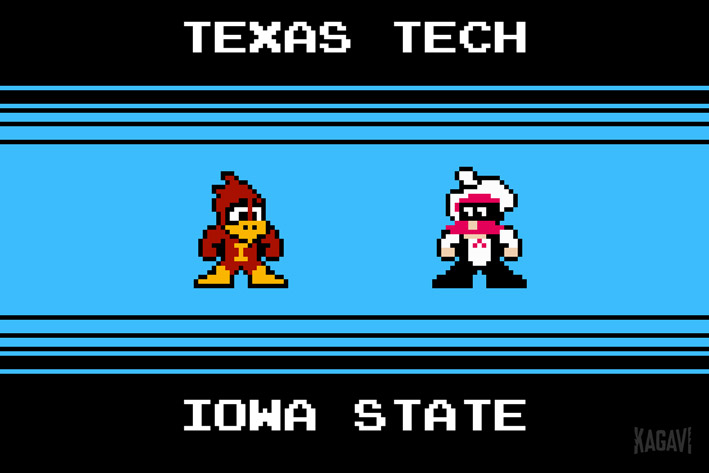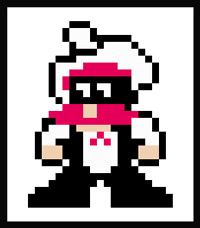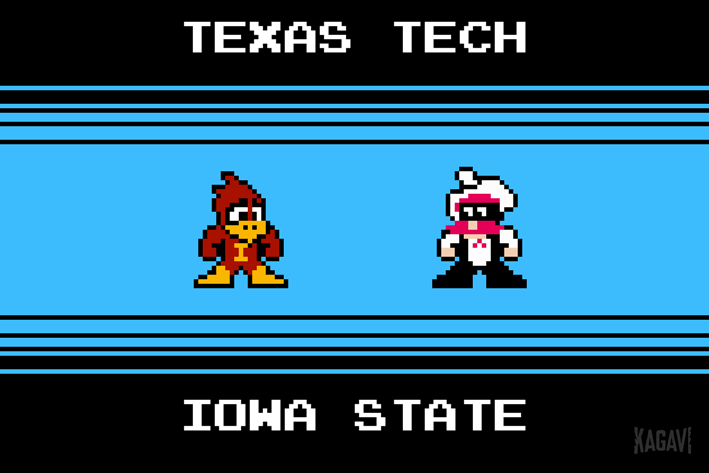
(Story originally posted on SB Nation’s ISU site: Wide Right & Natty Lite.)
_____________
WRNL is proud to present nine weekly articles from Kagavi leading up to the official release of The Adventures of Robot Cy, a fictional 8-bit video game trailer that never was.
In a faraway futuristic time, college football has been taken over by robot mascots. Join Robot Cy as he travels through many thrilling levels to find out who is behind this nefarious plot!
Every week during the conference season, Kagavi will preview the ISU football game using this project as inspiration by asking what power ups could Robot Cy gain by defeating the other Big 12 robot mascots?
_____________
The familiar rites of fall are always comforting: apple cider, carving pumpkins, autumn foliage, the powerful Iowa State football team in first place of the Big 12 Conference. Fresh off conquering Robot Jayhawk (and getting the Golden Horseshoes), the Cyclones are headed to Lubbock to face off against Texas Tech, which will be the “featured” game on Fox Sports Net channel again. The Cyclones almost beat them last year, but–get your fainting couches ready–a couple of missed field goals doomed ISU in the 34 – 31 loss. So far this year, the Texas Tech team has run the equivalent of nine ultra marathons simply trying to keep up with TCU and Baylor in recent games. ISU just may find the Red Raiders completely gassed, or the game could be over after the first quarter.
But what if Robot Cy was facing off against Robot Raider Red?
If Robot Raider Red used the best parts of Texas Tech football history to inspire a power up, what would it be? Let’s explore some Texas Tech history.

Texas Tech’s sprawling Spanish Renaissance campus is located in the swirling dust bowl of remote West Texas. The school is surprisingly young, only having been established in 1923 as Texas Technological College. Football followed two years later with the team originally named the Matadors. Before joining the Southwest Conference in 1956, Texas Tech played in the Wild West Border Conference for decades with Arizona, Arizona State, and New Mexico among other schools.
Before the Big 12 was formed, Iowa State had only played Texas Tech twice, in 1967 and 1974, with the Red Raiders wining by large margins both times in Lubbock. The overall historical record stands at 10 wins to 3 losses in favor of Texas Tech. Despite the often disparate talent levels, the two teams usually play close games with many decided by just one score.
In the early days of football, some interesting traditions took hold. Legend has it one of Texas Tech’s football squads in the 1930s became the first collegiate team to fly to a game by plane. (Further research shows this to be false: they were almost certainly preceded by the University of Omaha.) In a move that would’ve made Nike green with envy, Texas Tech unveiled flashy red satin uniforms in 1934, which eventually led to the Red Raiders nickname supplanting the Matadors team name. These days throwing tortillas has somehow become a crucial part of the game experience.
Despite starting late with football, six Texas Tech players have been elected to the College Football Hall of Fame, the first being E. J. Holub in 1986. (Side note: Holub had a long successful career with the Kansas City Chiefs as a linebacker and center, only deciding to retire after his 11th or 12th knee operation. Reports of the period are unclear on whether hay was used as replacement ligaments.)
Every cowboy needs a good watering hole and Lubbock is no exception. The water here is known to have some sort of mystical quality that makes it impossible to not score points. In 1930, Coach Peter Cawthon’s team supposedly led the country in scoring and in later decades Coach Mike Leach would continue this tradition in a big way.
Thanks to the Pirate Leach, the football program became widely admired for their ability to mint award-winning passers every single year from anywhere, regardless of actual talent level. Some of these players probably weren’t even real. Look at 2003–a guy named B. J. Symons won the Sammy Baugh Trophy given annually to the nation’s top passer over some doofus named Eli Manning. Cheerleaders have been known to throw for multiple touchdowns during mop up duty in games. If Texas Tech somehow suited up the famous P. T. Barnum performer Prince Randian, better known as the wondrous armless and legless Caterpillar Man, he would probably throw for 745 yards against Iowa State this weekend.
Another neat aspect of Texas Tech history is the Masked Rider mascot, which officially became part of university tradition in 1954. To date, there have been 14 horses with many having midnight or black-related names. In 1970, live animal mascots were banned at away games by the Southwest Conference (unless the host school explicitly allowed it), which prompted Texas Tech to create a second mascot: Raider Red. His two pistols were considered as a potential power up.
The Masked Rider actually got its unsanctioned start in a few games in 1936, and at the time, reports dubbed the mysterious figure a Ghost Rider, which fit in perfectly with the ghost town legends dotting the Wild West landscape of Texas. South of Lubbock, there is a legend of a headless horseman named El Muerto. No word on whether flaming pumpkins are involved. Although the Ghost Rider was replaced by the Masked Rider, they apparently never went away.
Consider how the Ghost Riders have helped in recent years. In 2008, Texas Tech hosted #1 Texas in a colossal clash and with mere seconds left, trailed 33 – 32. On the last play of the game, the Texas Tech quarterback fired a pass that was tipped by a wide receiver, and Texas intercepted the pass to preserve their perfect season. Except that’s not what happened. Upon closer review, the tipped ball became ghostly and somehow went right through Texas safety Blake Gideon’s waiting hands, preserving Texas Tech’s upset bid. The following play, Michael Crabtree won it with one second left.
This power of invisibility hasn’t been limited to just games. Sometime after the 1996 season, a player named Byron Hanspard consulted with the Ghost Riders and pointed them towards Ames, where another running back named Troy Davis was. Rendered invisible, Troy Davis lost the Doak Walker Trophy awarded to the nation’s best running back, as well as the Heisman Trophy. Had the voters been able to find Troy Davis, there would be two impressive pieces of hardware sitting in Ames these days.
Thus, after this brief look at Texas Tech history, it only seems appropriate that the power up for Robot Raider Red should be a homage to the Wild West history of Texas and the Ghost Riders legend.

The Ghost Riders power up gives Robot Cy a sorely needed boost of spectral luck. By using this power up, Robot Cy could make certain players invisible, rendering them harmless–or even entire teams (looking at you Oklahoma). If Robot Cy had access to this power up, what historical football (or basketball) seasons could have turned out much differently?
Are there any other possible power ups that would fit Robot Raider Red? Share them in the comments!
_____________
Visit Kagavi.com or follow them on Twitter at @Kagavi to keep up on all of their projects, including the celebrated Jack Trice series.
